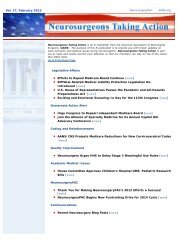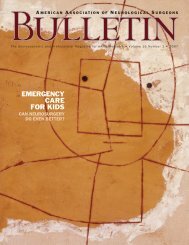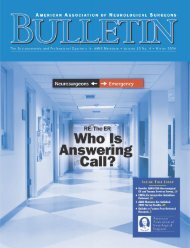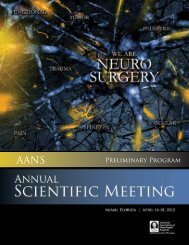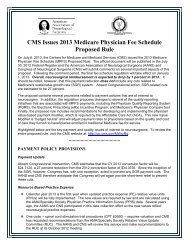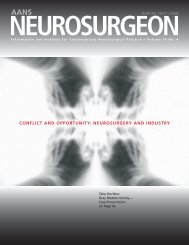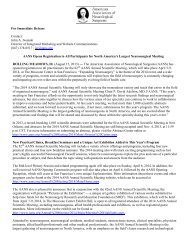view PDF - American Association of Neurological Surgeons
view PDF - American Association of Neurological Surgeons
view PDF - American Association of Neurological Surgeons
Create successful ePaper yourself
Turn your PDF publications into a flip-book with our unique Google optimized e-Paper software.
M EDICOLEGALU PDATE<br />
D AVID F. J IMENEZ, M D<br />
Texas Teaches That Tort Reform Works<br />
Will Other States Learn the Lesson<br />
Neurosurgeons are well aware <strong>of</strong> the<br />
significant financial impact that<br />
skyrocketing medical liability insurance<br />
premiums can have on their<br />
practices, and organized neurosurgery has<br />
been at the forefront <strong>of</strong> efforts to institute<br />
medical tort reform at both the federal and<br />
state levels.Yet a long-standing debate continues<br />
on the real impact <strong>of</strong> tort reform on<br />
malpractice insurance premiums. Some<br />
argue that there is no correlation between<br />
the capping <strong>of</strong> noneconomic damage<br />
awards and the annual insurance premiums<br />
and argue further that the premiums<br />
set by the insurance industry have nothing<br />
to do with jury verdicts and awards.<br />
However, medical tort reform enacted<br />
in Texas on Sept. 12, 2003, refutes that idea<br />
and supports the position that appropriate<br />
reforms will reduce medical malpractice<br />
premiums and increase patients’ access to<br />
care. In fact, Texas House Bill 4 and its constitutional<br />
amendment, Proposition 12,<br />
have served to reduce high rates <strong>of</strong> medical<br />
malpractice insurance by granting the<br />
Texas Legislature the authority to limit<br />
noneconomic medical civil liability damages<br />
to no more than $250,000 in medical<br />
malpractice lawsuits. The cap was established<br />
at $250,000 for all doctors (no matter<br />
how many are named in a lawsuit) and<br />
$250,000 per healthcare institution (up to<br />
two institutions). All actual medical<br />
expenses, lost past and future income and<br />
other expenses that can be translated into<br />
an actual dollar amount (such as maid service,<br />
transportation) are still recoverable.<br />
The reforms, which were intended to<br />
help reduce frivolous medical malpractice<br />
lawsuits and to decrease escalating medical<br />
liability insurance rates, began to pay dividends<br />
soon after enactment. As early as<br />
Jan. 1, 2004, Texas Medical Liability Trust,<br />
the largest medical malpractice insurer in<br />
Texas, reduced its rates by 12 percent across<br />
the board. This was followed nine months<br />
later by another 5 percent rate reduction.<br />
Between February 2005 and March 2006,<br />
additional rate decreases were announced<br />
by numerous other Texas pr<strong>of</strong>essional liability<br />
insurance underwriters, including<br />
<strong>American</strong> Physicians Insurance Company<br />
(9 percent–14 percent), The Joint Underwriting<br />
<strong>Association</strong> (10 percent), Medical<br />
Protective (2 percent), Texas Medical Liability<br />
(an additional 5 percent) and The<br />
Doctors Company (18 percent).<br />
In 2005, Bernard Black and colleagues<br />
reported that the total number <strong>of</strong> medical<br />
malpractice claims for 2002 was 6,929<br />
compared with a high <strong>of</strong> 8,943 claims filed<br />
the preceding year. In 2003, the year in<br />
which tort reform passed, there was a<br />
transition drop in claims to 5,967 as<br />
reported to the Texas Department <strong>of</strong><br />
Insurance by the four largest medical malpractice<br />
insuring companies in Texas; figures<br />
from these companies represent<br />
claims for approximately 60 percent <strong>of</strong><br />
Texas physicians, according to Kenneth<br />
McDaniel <strong>of</strong> the Texas Department <strong>of</strong><br />
Insurance Pr<strong>of</strong>essional Liability Commercial<br />
Property/Casualty Division. Additional<br />
decreases in claim rates also are being<br />
observed using the same TDI data set,<br />
indicating a reduction in medical malpractice<br />
claims in 2004 to 2,359 and in<br />
2005 to 2,259. The overall number <strong>of</strong><br />
claims in 2005 was roughly just one third<br />
<strong>of</strong> the number reported in 2002, the year<br />
immediately prior to reform enactment.<br />
This dramatic difference is echoed by<br />
Texas Department <strong>of</strong> Insurance data which<br />
shows that medical malpractice lawsuit filings<br />
decreased by half by 2006. Additionally,<br />
the agency reported its action to deny<br />
rate increases that did not take into account<br />
the reduced exposure to frivolous claims.<br />
The agency further reported that within<br />
months <strong>of</strong> reform passage, it had been con-<br />
tacted by more than two dozen companies<br />
for information on entering the malpractice<br />
insurance market, and an insurer who<br />
had announced plans to pull out <strong>of</strong> the<br />
Texas market began expanding and writing<br />
new business.<br />
The reforms have wrought additional<br />
beneficial changes in Texas healthcare,<br />
among them:<br />
3 From May 2003 through July 2005 there<br />
was an increase <strong>of</strong> approximately 3,000<br />
new doctors establishing practices in Texas,<br />
many <strong>of</strong> whom serve in high-risk specialty<br />
medicine. (Texas Medical <strong>Association</strong>,<br />
March 23, 2006).<br />
3 Some Texas communities (Corpus<br />
Christi, Beaumont, the Rio Grande Valley,<br />
Webb County) are experiencing surges in<br />
physician recruitment (<strong>American</strong> Medical<br />
<strong>Association</strong>, May 9, 2005).<br />
3 Texas physicians are now able to shop<br />
for medical malpractice insurance since the<br />
number <strong>of</strong> new and start-up medical<br />
malpractice insurers increased from four<br />
pre-reform to roughly 20 new entities.<br />
(Beaumont Enterprise, Feb. 22, 2005).<br />
Texas teaches that appropriate medical<br />
tort reform does indeed work. It lowers<br />
medical malpractice premiums and<br />
increases the number <strong>of</strong> available doctors,<br />
thus increasing patients’ access to care. An<br />
important caveat, however, is that Texas<br />
voters passed a constitutional amendment<br />
that makes it highly unlikely for the state’s<br />
high court to overturn the cap. The question<br />
now is whether other states will learn<br />
Texas’ very valuable lesson. 3<br />
David F. Jimenez, MD, FACS, is pr<strong>of</strong>essor<br />
and chair <strong>of</strong> the Department <strong>of</strong> Neurosurgery<br />
at the University <strong>of</strong> Texas Health Science<br />
Center, San Antonio.<br />
34 Vol. 15, No. 2 • 2006 • AANS Bulletin




